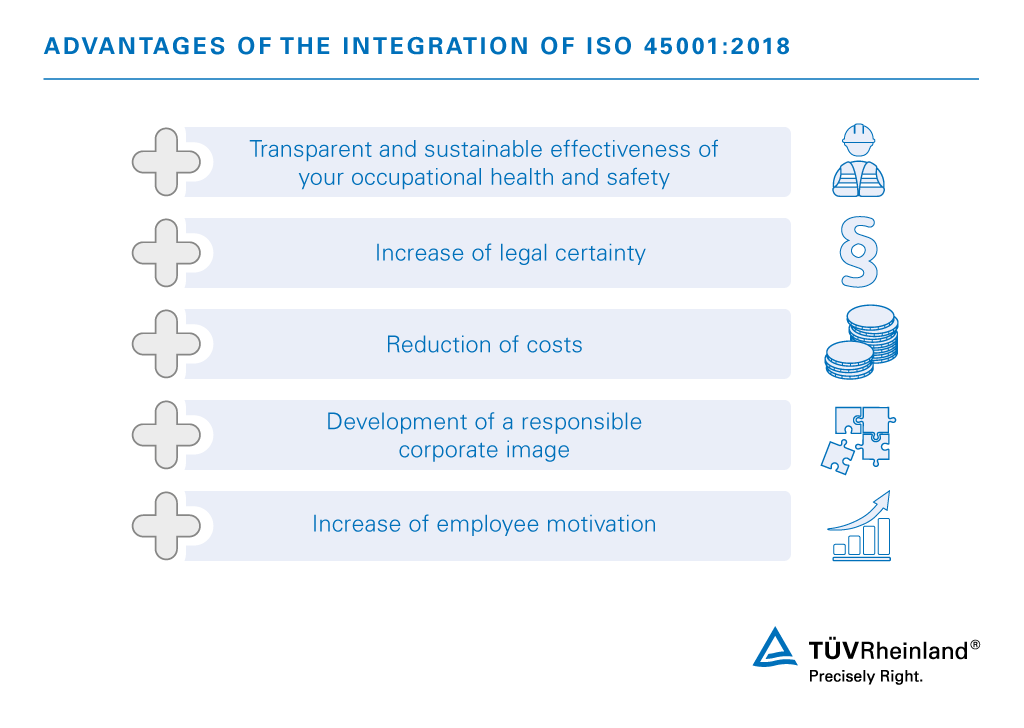New standard for occupational health and safety
The ISO 45001:2018 standard for occupational health and safety management systems was published on 12 March 2018. It replaces the previous standard for occupational health and safety, BS OHSAS 18001:2007. This new standard specifies requirements for effective occupational health and safety processes and additionally provides guidance on how to implement them. Thus it ensures safety and protection of the physical and mental health of all employees as well as of visitors and contractors.
With the publication of ISO 45001:2018, companies, whose occupational health and safety management systems are currently certified to BS OHSAS 18001:2007, are given a three-year transition period. The new standard will be applicable for all companies, regardless of their type, size or product orientation. Thanks to the structural adjustment to other standards, the integration into existing management systems will be facilitated.
Below our experienced experts answer the most frequently asked questions concerning the new ISO 45001:2018 standard:
- What are the changes you will face in practice?
- What are the objectives and advantages of ISO 45001:2018?
- What are the next steps you should take?
Do you wish to learn more about the next steps to be taken? Please get in touch with us! Our experts will be happy to provide you with information.
What will be the changes you will face in practice concerning occupational health and safety?
New requirements for an effective occupational health and safety management system according to ISO 45001:2018
The new standard focuses on the preventive protection of employees. This reduces the risks of work-related injuries, accidents or illnesses significantly. But the standard also focuses on the increased responsibility and active involvement of managers. Thanks to appropriate processes and management methods, the integration of occupational health and safety management systems can take place at all levels of a company and be sustainably implemented. Furthermore, the participation of employees and an occupational health and safety culture are more strongly promoted.
The continuous processes required by ISO 45001:2018 significantly facilitate the targeted control and thus the sustainable effectiveness of occupational health and safety management systems.
Changes of ISO 45001 relevant for practice: Uniform structure of management systems
As in the previous BS OHSAS 18001:2007 standard, the implementation is based on the “Plan–Do–Check–Act“-Model” (PDCA Model).
A significant change, however, is the new “High Level Structure”, which ensures a harmonization of management system standards. It has already been used in the ISO 9001:2015 standard for quality management systems or in the ISO 14001:2015 standard for environment management systems. A uniform structure and consistent definitions and terminology pave the way to an uncomplicated integrated management system.
Other changes concern the proactive consideration of the context of the organization in order to identify influencing topics, interested parties and their expectations. It also takes into consideration temporary employees, subcontractors and suppliers.
There is also an increased focus on risk analyses in order to identify opportunities and risks for improving occupational health and safety.
Objectives of the integration of ISO 45001:2018
The integration of the new standard for occupational health and safety management systems has several objectives. On the one hand an effective and comprehensive occupational health and safety management system is implemented thanks to the process-oriented structure of ISO 45001:2018. The intention is to increase international recognition, among others from customers and authorities. On the other hand the aim is to improve and establish a safe and healthy working environment for employees and other persons under their responsibility. In addition, a continuous improvement of the occupational health and safety management system shall be achieved by means of the PDCA Model.
Advantages of the integration of ISO 45001:2018
A management system for health and safety at work is primarily designed to provide a stable and controlled level of health and safety. This helps you and your employees to remain accident-free, healthy and thus efficient – even in increasingly complex and dynamic times.
The integration of ISO 45001 helps you to significantly reduce your costs. By including occupational health and safety in management, you also meet legal requirements and thus increase legal certainty.
Build up a responsible corporate image thanks to the transparency and sustainable effectiveness of your occupational health and safety. In this way you can show your customers and suppliers as well as authorities and investors that you attach great importance to occupational health and safety in your company. In addition, you can increase the motivation of your employees decisively. Thanks to early participation, they are included in the planning and implementation right from the start.
Implementation of ISO 45001:2018: What should you do?
The transition period should be used to implement all necessary measures as early as possible. Otherwise, later, you will come under pressure to act.
The new standard offers companies more possibilities to design the occupational health and safety management system in a company-specific manner and to adapt it individually to the needs of the company. We therefore recommend to first review the existing occupational health and safety and occupational health and safety management system. From this, company-specific measures for adapting to the new requirements can be derived. Pay particular attention to the terms explicitly defined in ISO 45001:2018, such as accident/incident, risk/opportunity, context, employee and participation/cooperation.
It is advisable to carry out the migration as a project and to create a corresponding project plan. This ensures a systematic approach to the implementation of all measures and the revision of the occupational health and safety management system.
Furthermore, integrate the relevant employees in good time and ensure comprehensive training and knowledge of the new standard. You will then verify if the new regulations are effective and incorporate these findings into a restructured management evaluation. If you lack the knowledge or necessary resources, ask for professional advice at an early stage.
Our experts provide you with information concerning ISO 45001:2018
If you have already been certified to OHSAS 18001:2007, adaptation to the elements of the High Level Structure in particular is necessary. Our experts will identify the possible ways of implementation according to the new requirements. In addition, we advise you on the pragmatic implementation of these and eliminate differences.
During the initial implementation of ISO 45001:2018, we work with you to prepare a targeted Gap Analysis of your current occupational health and safety organization in the company. If desired, we will then implement the requirements of ISO 45001:2018 together with you.
Further steps in the implementation of ISO 45001
We support you by providing individual consulting and agile project management. Thanks to many years of experience, we can assist you in the efficient introduction and implementation of your occupational health and safety management system until you will be ready for certification according to ISO 45001:2018.
Our services include:
- Systematic analysis of the internal occupational health and safety organization
- Preparation of a compliance check
- Process management (initial recording and optimization of process capability)
- Preparation of management system documentation
- Training of employees and managers and raising their awareness
- Preparation and execution of occupational health and safety management system audits
- Preparation of the occupational health and safety management review
- Provision of an external representative for the occupational health and safety management system
- Additional specialist advice on: System and operational safety, emergency preparedness and response, explosion protection and product safety
Contact










